Garlic Mustard Is The Leafy Green That's Nothing Like It Sounds
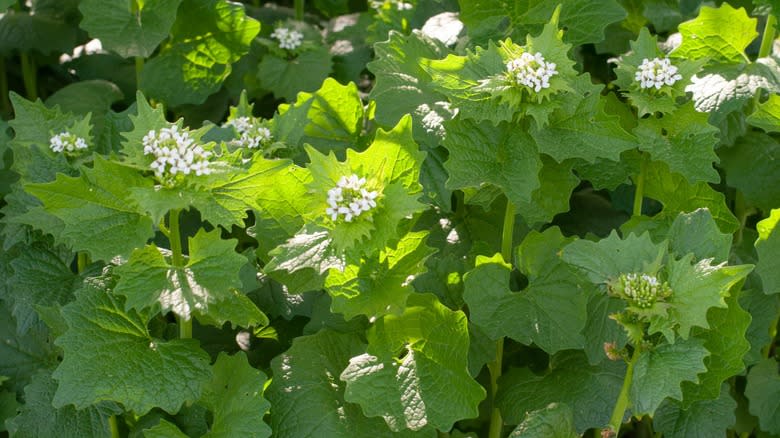
If you hear about a recipe involving garlic mustard, you may assume it's referring to the garlic-infused topping. To make matters more confusing, there are plenty of these jars on the market, including the popular Trader Joe's condiment, Aioli Garlic Mustard Sauce. But, while you can find this flavor combo in a variety of grocery store products, garlic mustard itself is something different entirely. It's an edible weed, annoying for gardeners but tasty for home cooks. You may also see it called by its scientific name, Alliaria petiolata, or one of its many nicknames: poor man's mustard, hedge garlic, garlic root, mustard root, garlicwort, sauce-alone, and jack-by-the-hedge.
Garlic mustard is considered an invasive species outside of its native Europe and Asia, with organizations like The Nature Conservancy urging people to "help stop its spread." As such, there's no shortage of the plant -- in fact, The Nature Conservancy says that, in its two-year lifespan, one plant can generate as many as 7,000 seeds. So, with the excess of garlic mustard out there, why not learn how to use it in your kitchen? You'll be doing the planet a favor.
While we've yet to embark on a foraging mission for garlic mustard ourselves, we called on The Nature Conservancy, New York Invasive Species Information, and similar organizations to provide pertinent information about the plant's appearance, background, and flavor. And, to get the scoop on its nutritional information, we turned to a study in the Journal of Food Biochemistry, as well as several medically reviewed articles from Healthline.
Read more: 23 Types Of Potatoes And When To Use Them
What Is Garlic Mustard?

Garlic mustard is an edible weed. As part of the Brassicaceae plant family, its relatives include other cultivated flowering plants like arugula, cabbage, and horseradish. Though you can find it all over the U.S. today, it's actually native to Europe and Asia, where it was originally consumed as a green and used as medicine. In the 1860s, Europeans brought the weed over to Long Island, New York, and it then spread like wildfire all over North America.
While garlic mustard can be harvested and every part of the plant is edible, it's also highly disruptive because it can prevent fungi from growing in forests, which halts the flow of nutrients to native plants. Plus, garlic mustard doesn't have any natural predators in the U.S., so it can be difficult to control. To make matters worse, its growing season starts earlier than that of most native plants, so it has an extra jump on consuming nutrients in the area.
But, as difficult as it may be to stop the spread of garlic mustard, it's easy to identify the species. Young plants have dark green leaves that are prominently veined, kidney-shaped, and have scalloped edges, while the leaves become triangular with distinct teeth in their second year. In May, you'll see tiny white flowers with four petals in the latter, with small seed pods emerging later on in the summer.
Garlic Mustard Vs. Wild Violets
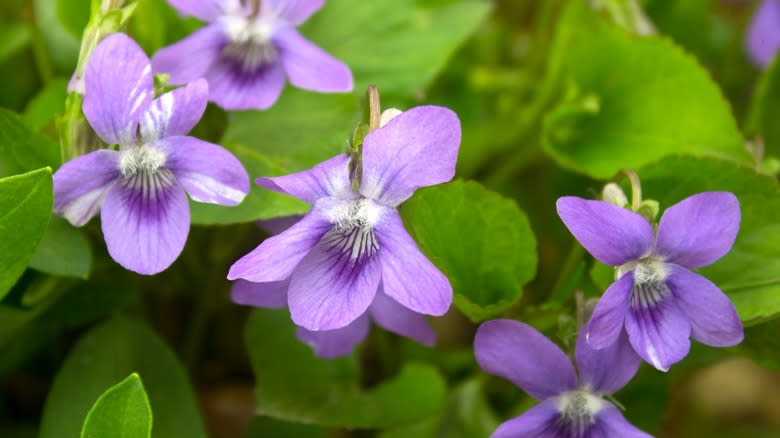
While the fully formed flowers of garlic mustard and wild violets (pictured) look pretty different -- the former are white while the latter are typically purple -- these plants are surprisingly similar in a few key ways. Perhaps most importantly, they're both considered invasive species (aka weeds). Home gardeners often try to use wild violets as ground cover, meaning they're intended to protect their other plants against growing weeds, but they end up doing just the opposite. If not controlled, they can quickly generate new shoots and spread their seeds all over your backyard.
It can be easy to mistake wild violets for garlic mustard before the two plants begin to flower, as their leaves look very similar and both species are edible. But there is a quick way to tell if the young weeds taking over your garden are garlic mustard or wild violets (aside from the color of their flowers): Check the stems. Garlic mustard has hairy, reddish stems that grow into the ground at an angle, while violets have hairless, fully green stems that shoot straight into the dirt.
Crushing a few leaves of the plants is also helpful, as only garlic mustard releases a powerful garlic-like scent. While we wouldn't recommend taste-testing these plants for identification purposes, they also have entirely different flavors. Wild violet flowers taste mildly floral, and the leaves have a slightly sweet taste.
What Does Garlic Mustard Taste Like?

Despite the fact that it's a weed, garlic mustard is edible, so its flavor is worth discussing -- but keep in mind that different parts of the plant will have varying tastes. The roots taste like horseradish, pungent and spicy, while the edible seeds boast a garlic flavor. If you squeeze the plant's leaves, you'll also notice a distinct garlic aroma and a taste that hovers between garlic and mustard greens, hence the name of the plant. Young stems -- considered by many to be the best part -- are sweeter, like snap peas.
The leaves become even more bitter if the plant bolts (aka if it starts producing flowers and seeds), so you may want to pick them early on while their signature flavors are still present. In general, you'll want to consume garlic mustard when it's young because the plants produce more cyanide the older they get -- though this can be removed by boiling or blanching. The flowers have a sweet, garlicky flavor like slightly bitter greens, while the plant's vegetative parts have a soft texture and spicy herbal taste and can be used in place of your favorite microgreens.
How To Cook With Garlic Mustard
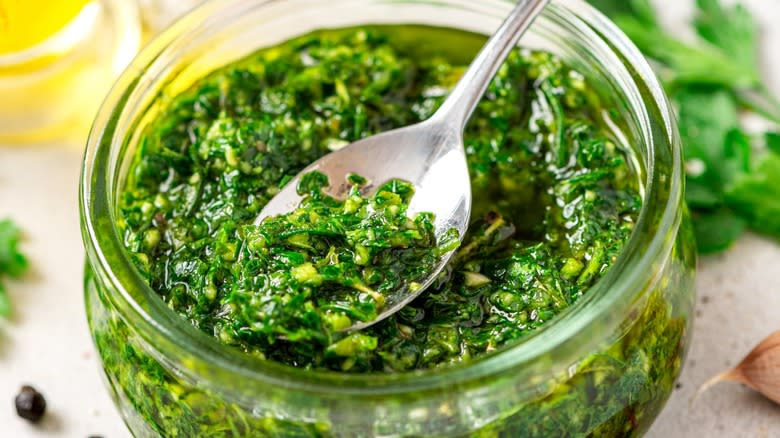
The leaves of the garlic mustard plant are the most commonly used part in cooking, as they're simply the most versatile. Before deploying them, you'll want to wash and dry them thoroughly. Then, try replacing the basil in a bright and fresh pesto recipe with garlic mustard, or use a combination of the two greens for a milder flavor. The garlicky, mustard flavors of this type of pesto work well on pork chops, pasta, salmon, and other entrées.
However, you can also use the leaves in a hummus or chimichurri recipe, where they'll add a pungent flavor upgrade. Bonus points if you blend the spicy roots in, too, but make sure to start small and taste as you go since their flavors are strong. You can also sauté, steam, or blanch the greens if you'd like to tone down their bitter flavor and add them to dishes where they can balance out richer ingredients like scrambled eggs and creamy pasta sauces. Or, pair them with other veggies in stir-fries, grain bowls, salads, and sandwiches.
If you'd like to experiment with the other parts of the plant, try sprinkling the seeds anywhere you'd use minced garlic or mustard powder, keeping in mind that their flavor is slightly different. As for the milder-tasting flowers and sprouts, you can use them as a fresh garnish for eggs, toast, pasta, and soups.
Where To Get Garlic Mustard

If you're one of the lucky few who spots garlic mustard dominating your yard, you may not need to buy it at all -- and harvesting it may be as much of a lifeline for your native plants as it is a unique cooking ingredient to try out. But, if you're not blessed with a garlic mustard garden takeover, you may be able to find it along trails in forests, parks, and other public places when it's in season from late winter to mid-summer.
Be careful when departing on a foraging adventure for the weed unless you're a seasoned expert, and, when in doubt, crush the leaves in your hands to identify that signature garlic aroma. Unlike harvesting other foraged plants, discretion is not needed once you find a patch of garlic mustard. Feel free to pick as much as you can, as you're helping the local habitat by harvesting it.
Since The Nature Conservancy (and many other organizations) identify garlic mustard as an invasive species that threatens the biodiversity of native ecosystems, it's not advisable to plant its seeds yourself, although you can find packets at many online retailers. It's also not typically found in grocery stores. If you're interested in discovering where to harvest it in your area, reach out to a local nature center for advice.
Nutritional Information About Garlic Mustard
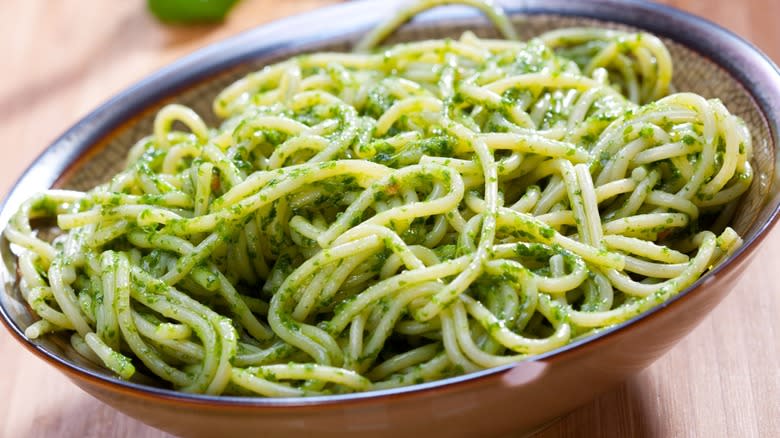
If you manage to get your hands on it, garlic mustard has a high nutritional value, much like other leafy greens. According to a 2007 study published in the Journal of Food Biochemistry, it's packed full of vitamin C, carotenoids, fiber, fatty acids, and oxalic acid. The study also found that "mineral elements were present at higher concentrations than is common for other leafy green vegetables," which included calcium, potassium, magnesium, phosphorus, iron, copper, zinc, and manganese.
Carotenoids are a group of antioxidants that include beta-carotene, a common pigment found in carrots. According to Healthline, carotenoids may help boost eye and cardiovascular health and may even help protect against cancer. Oxalic acid, on the other hand, may stop our bodies from fully absorbing minerals and can potentially lead to kidney stones. Healthline advises that, while most people can tolerate the acid in moderation, those who are susceptible to gut issues or kidney stones may want to stay away from it.
It's also important to note that garlic mustard contains small amounts of cyanide -- which, again, is generally fine to eat in moderation. But, if you're consuming older leaves or just want to stay on the safe side, make sure to cook them first as this removes the toxic compound from the plant.
How To Store Garlic Mustard
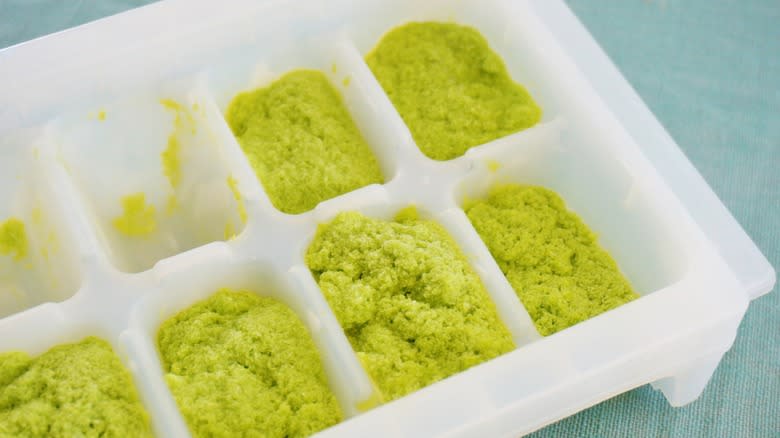
After you've harvested your garlic mustard, you'll want to wash and dry the leaves as soon as possible. Ideally, you'll deploy them as soon as they're dry for the freshest taste -- but, if you can't, keep them in an air-tight container, where they'll last for up to 10 days in the fridge. Almost all other parts of the plant will stay fresh for up to two weeks if stored in a similar manner in the fridge.
If you just want to consume the flowers, don't wash them until right before you're ready to use them or they'll break down and become soggy. Lastly, if you'd like to extend the life of your garlic mustard leaves a little longer, use them to make pesto as soon as you wash and dry them. Your final product should be good for up to a month in the fridge or up to six months in the freezer.
Read the original article on Tasting Table.

